Singapore Kindness and Social Graces
VerifiedAdded on 2020/02/24
|16
|3744
|274
AI Summary
This assignment delves into the concept of kindness and social graces in Singapore. It presents a questionnaire designed to gauge individuals' participation in various social activities like donating, volunteering, and welcoming foreigners. The survey also aims to assess how Singaporeans perceive improvements in aspects such as offering help, local acceptance of foreigners, and observance of social rules. Participants rate these factors on a scale of 1 to 10, indicating their level of agreement.
Contribute Materials
Your contribution can guide someone’s learning journey. Share your
documents today.
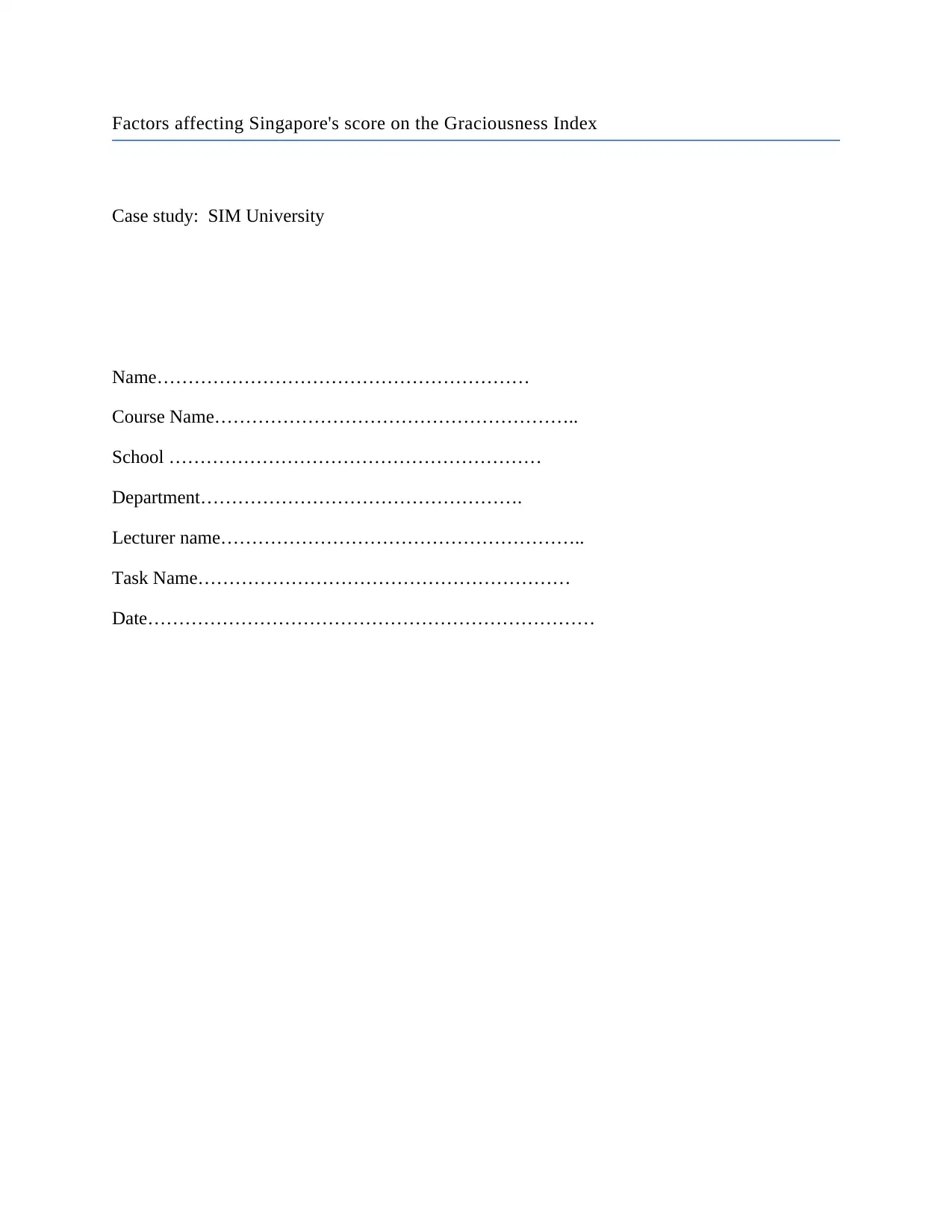
Factors affecting Singapore's score on the Graciousness Index
Case study: SIM University
Name……………………………………………………
Course Name…………………………………………………..
School ……………………………………………………
Department…………………………………………….
Lecturer name…………………………………………………..
Task Name……………………………………………………
Date………………………………………………………………
Case study: SIM University
Name……………………………………………………
Course Name…………………………………………………..
School ……………………………………………………
Department…………………………………………….
Lecturer name…………………………………………………..
Task Name……………………………………………………
Date………………………………………………………………
Secure Best Marks with AI Grader
Need help grading? Try our AI Grader for instant feedback on your assignments.
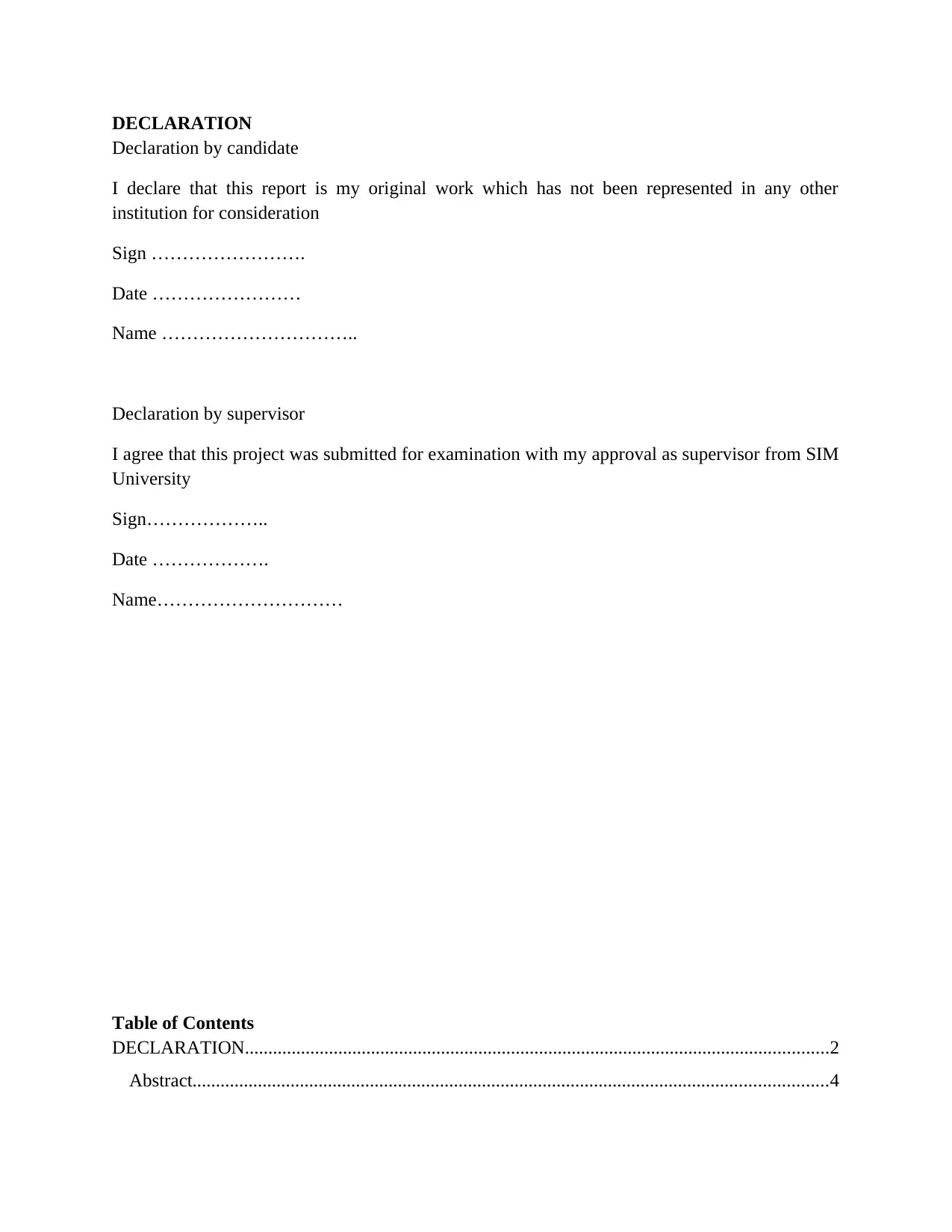
DECLARATION
Declaration by candidate
I declare that this report is my original work which has not been represented in any other
institution for consideration
Sign …………………….
Date ……………………
Name …………………………..
Declaration by supervisor
I agree that this project was submitted for examination with my approval as supervisor from SIM
University
Sign………………..
Date ……………….
Name…………………………
Table of Contents
DECLARATION.............................................................................................................................2
Abstract........................................................................................................................................4
Declaration by candidate
I declare that this report is my original work which has not been represented in any other
institution for consideration
Sign …………………….
Date ……………………
Name …………………………..
Declaration by supervisor
I agree that this project was submitted for examination with my approval as supervisor from SIM
University
Sign………………..
Date ……………….
Name…………………………
Table of Contents
DECLARATION.............................................................................................................................2
Abstract........................................................................................................................................4

Literature review..........................................................................................................................5
1.0 Introduction...................................................................................................................5
1.1 Theoretical literature review..............................................................................................5
1.2 Empirical literature review.................................................................................................6
1.3 Research Hypothesis..........................................................................................................6
1.4 Justification of the study.....................................................................................................7
Research Methodology................................................................................................................8
2.0 Introduction........................................................................................................................8
2.1 Research Design.................................................................................................................8
2.2 Sampling procedures..........................................................................................................8
2.3 Data description..................................................................................................................9
2.4 Data collection and analysis...............................................................................................9
Conclusion.................................................................................................................................11
Appendices.............................................................................................................................12
Abstract
Graciousness or level of kindness has become an important factor due to corporate scandals and
improved public relation. It is one of consideration in many countries and businesses. According
1.0 Introduction...................................................................................................................5
1.1 Theoretical literature review..............................................................................................5
1.2 Empirical literature review.................................................................................................6
1.3 Research Hypothesis..........................................................................................................6
1.4 Justification of the study.....................................................................................................7
Research Methodology................................................................................................................8
2.0 Introduction........................................................................................................................8
2.1 Research Design.................................................................................................................8
2.2 Sampling procedures..........................................................................................................8
2.3 Data description..................................................................................................................9
2.4 Data collection and analysis...............................................................................................9
Conclusion.................................................................................................................................11
Appendices.............................................................................................................................12
Abstract
Graciousness or level of kindness has become an important factor due to corporate scandals and
improved public relation. It is one of consideration in many countries and businesses. According
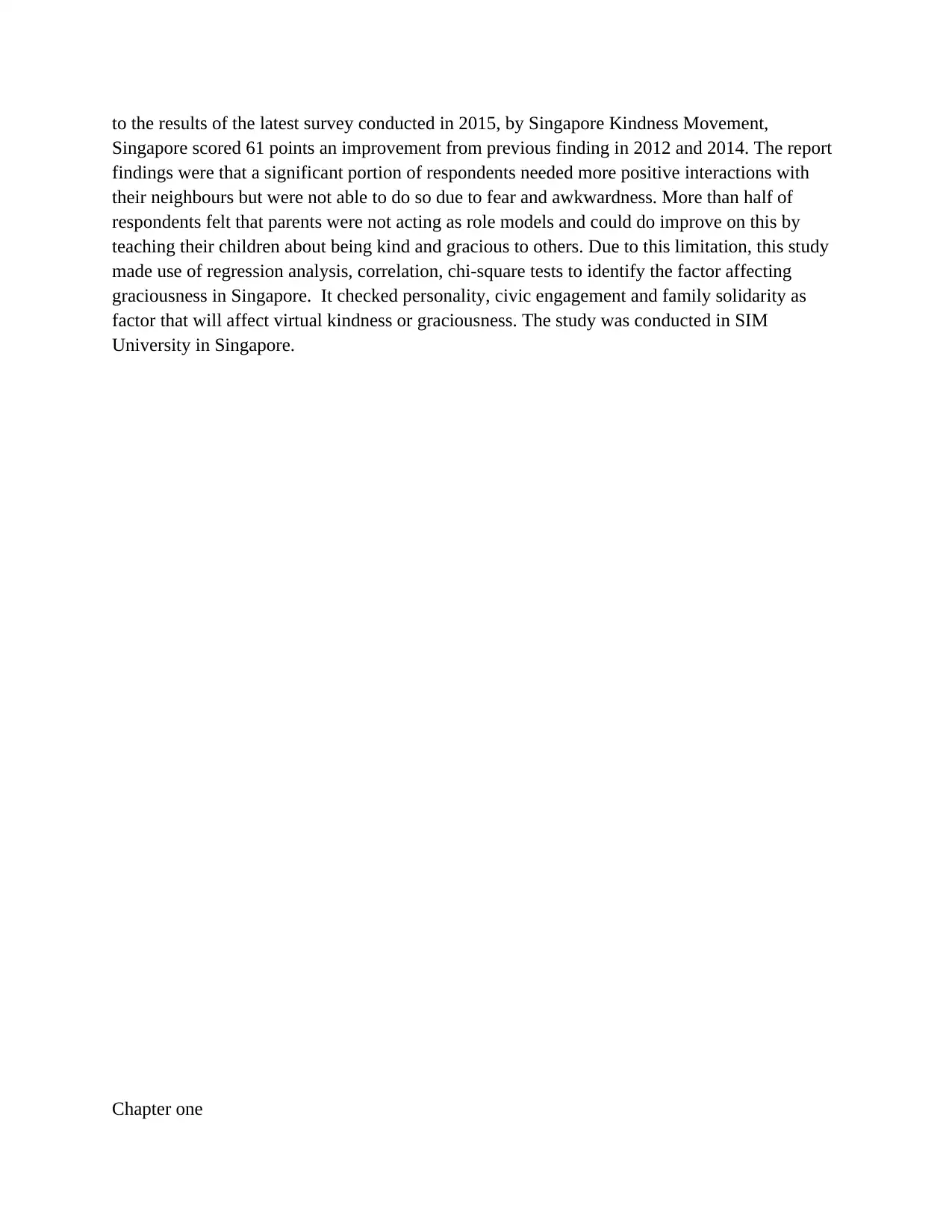
to the results of the latest survey conducted in 2015, by Singapore Kindness Movement,
Singapore scored 61 points an improvement from previous finding in 2012 and 2014. The report
findings were that a significant portion of respondents needed more positive interactions with
their neighbours but were not able to do so due to fear and awkwardness. More than half of
respondents felt that parents were not acting as role models and could do improve on this by
teaching their children about being kind and gracious to others. Due to this limitation, this study
made use of regression analysis, correlation, chi-square tests to identify the factor affecting
graciousness in Singapore. It checked personality, civic engagement and family solidarity as
factor that will affect virtual kindness or graciousness. The study was conducted in SIM
University in Singapore.
Chapter one
Singapore scored 61 points an improvement from previous finding in 2012 and 2014. The report
findings were that a significant portion of respondents needed more positive interactions with
their neighbours but were not able to do so due to fear and awkwardness. More than half of
respondents felt that parents were not acting as role models and could do improve on this by
teaching their children about being kind and gracious to others. Due to this limitation, this study
made use of regression analysis, correlation, chi-square tests to identify the factor affecting
graciousness in Singapore. It checked personality, civic engagement and family solidarity as
factor that will affect virtual kindness or graciousness. The study was conducted in SIM
University in Singapore.
Chapter one
Secure Best Marks with AI Grader
Need help grading? Try our AI Grader for instant feedback on your assignments.
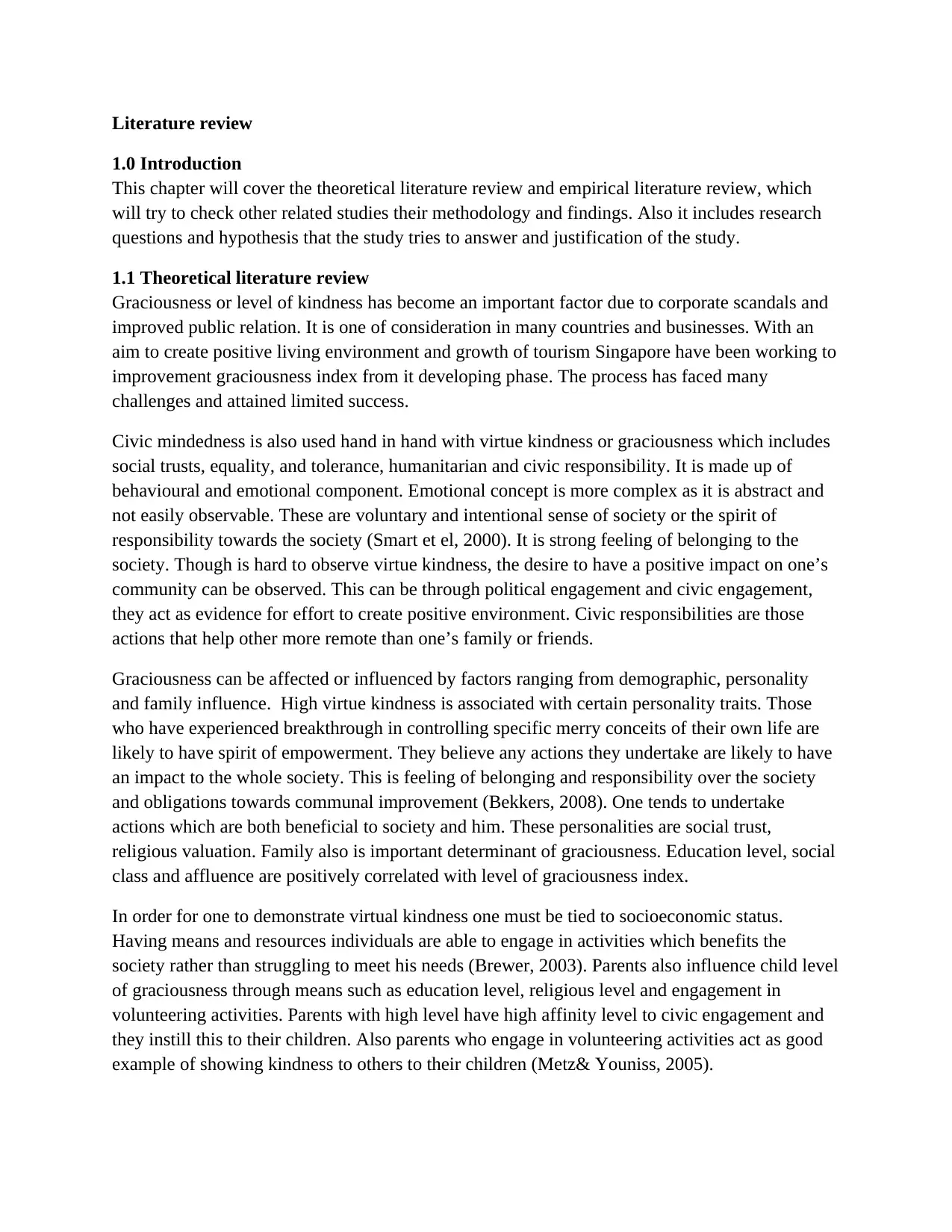
Literature review
1.0 Introduction
This chapter will cover the theoretical literature review and empirical literature review, which
will try to check other related studies their methodology and findings. Also it includes research
questions and hypothesis that the study tries to answer and justification of the study.
1.1 Theoretical literature review
Graciousness or level of kindness has become an important factor due to corporate scandals and
improved public relation. It is one of consideration in many countries and businesses. With an
aim to create positive living environment and growth of tourism Singapore have been working to
improvement graciousness index from it developing phase. The process has faced many
challenges and attained limited success.
Civic mindedness is also used hand in hand with virtue kindness or graciousness which includes
social trusts, equality, and tolerance, humanitarian and civic responsibility. It is made up of
behavioural and emotional component. Emotional concept is more complex as it is abstract and
not easily observable. These are voluntary and intentional sense of society or the spirit of
responsibility towards the society (Smart et el, 2000). It is strong feeling of belonging to the
society. Though is hard to observe virtue kindness, the desire to have a positive impact on one’s
community can be observed. This can be through political engagement and civic engagement,
they act as evidence for effort to create positive environment. Civic responsibilities are those
actions that help other more remote than one’s family or friends.
Graciousness can be affected or influenced by factors ranging from demographic, personality
and family influence. High virtue kindness is associated with certain personality traits. Those
who have experienced breakthrough in controlling specific merry conceits of their own life are
likely to have spirit of empowerment. They believe any actions they undertake are likely to have
an impact to the whole society. This is feeling of belonging and responsibility over the society
and obligations towards communal improvement (Bekkers, 2008). One tends to undertake
actions which are both beneficial to society and him. These personalities are social trust,
religious valuation. Family also is important determinant of graciousness. Education level, social
class and affluence are positively correlated with level of graciousness index.
In order for one to demonstrate virtual kindness one must be tied to socioeconomic status.
Having means and resources individuals are able to engage in activities which benefits the
society rather than struggling to meet his needs (Brewer, 2003). Parents also influence child level
of graciousness through means such as education level, religious level and engagement in
volunteering activities. Parents with high level have high affinity level to civic engagement and
they instill this to their children. Also parents who engage in volunteering activities act as good
example of showing kindness to others to their children (Metz& Youniss, 2005).
1.0 Introduction
This chapter will cover the theoretical literature review and empirical literature review, which
will try to check other related studies their methodology and findings. Also it includes research
questions and hypothesis that the study tries to answer and justification of the study.
1.1 Theoretical literature review
Graciousness or level of kindness has become an important factor due to corporate scandals and
improved public relation. It is one of consideration in many countries and businesses. With an
aim to create positive living environment and growth of tourism Singapore have been working to
improvement graciousness index from it developing phase. The process has faced many
challenges and attained limited success.
Civic mindedness is also used hand in hand with virtue kindness or graciousness which includes
social trusts, equality, and tolerance, humanitarian and civic responsibility. It is made up of
behavioural and emotional component. Emotional concept is more complex as it is abstract and
not easily observable. These are voluntary and intentional sense of society or the spirit of
responsibility towards the society (Smart et el, 2000). It is strong feeling of belonging to the
society. Though is hard to observe virtue kindness, the desire to have a positive impact on one’s
community can be observed. This can be through political engagement and civic engagement,
they act as evidence for effort to create positive environment. Civic responsibilities are those
actions that help other more remote than one’s family or friends.
Graciousness can be affected or influenced by factors ranging from demographic, personality
and family influence. High virtue kindness is associated with certain personality traits. Those
who have experienced breakthrough in controlling specific merry conceits of their own life are
likely to have spirit of empowerment. They believe any actions they undertake are likely to have
an impact to the whole society. This is feeling of belonging and responsibility over the society
and obligations towards communal improvement (Bekkers, 2008). One tends to undertake
actions which are both beneficial to society and him. These personalities are social trust,
religious valuation. Family also is important determinant of graciousness. Education level, social
class and affluence are positively correlated with level of graciousness index.
In order for one to demonstrate virtual kindness one must be tied to socioeconomic status.
Having means and resources individuals are able to engage in activities which benefits the
society rather than struggling to meet his needs (Brewer, 2003). Parents also influence child level
of graciousness through means such as education level, religious level and engagement in
volunteering activities. Parents with high level have high affinity level to civic engagement and
they instill this to their children. Also parents who engage in volunteering activities act as good
example of showing kindness to others to their children (Metz& Youniss, 2005).
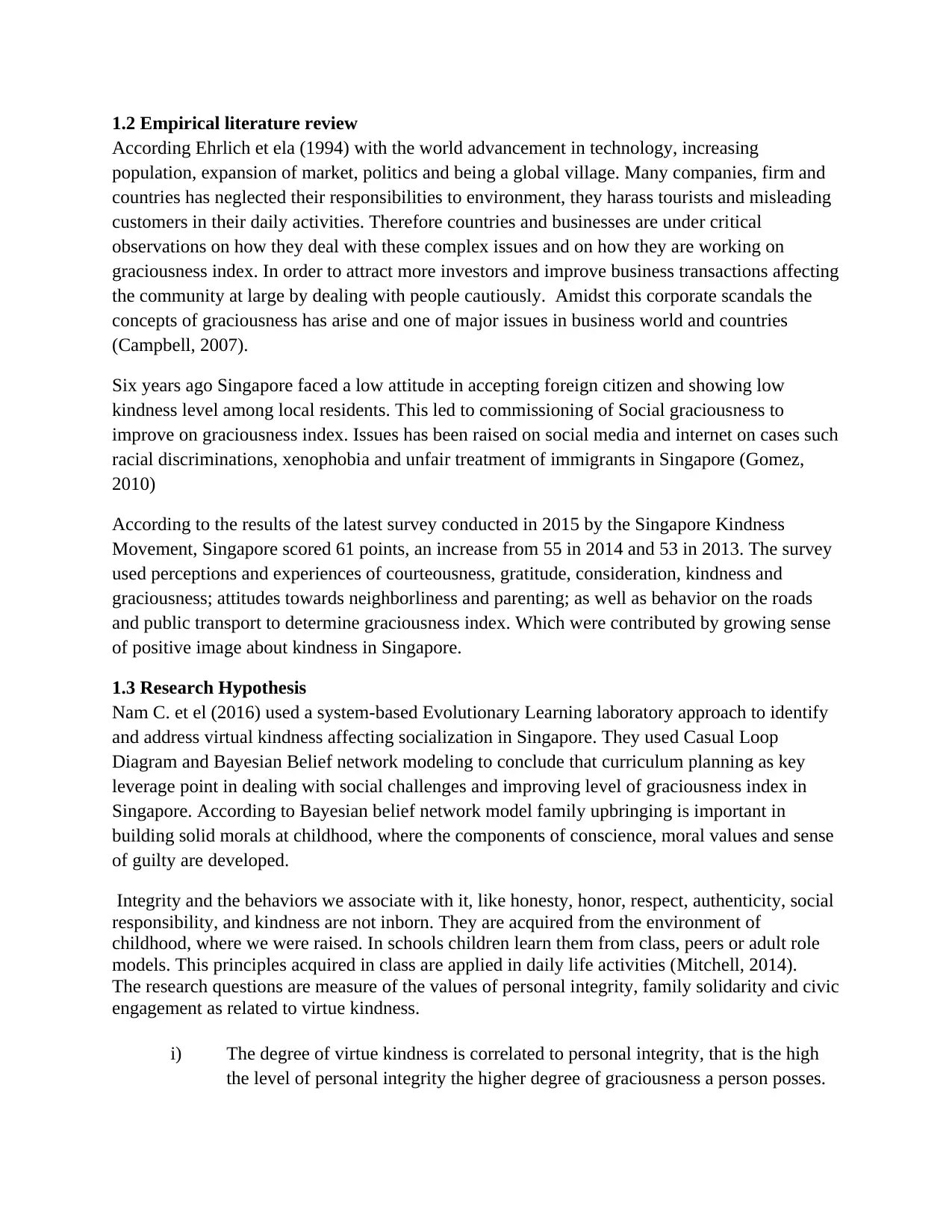
1.2 Empirical literature review
According Ehrlich et ela (1994) with the world advancement in technology, increasing
population, expansion of market, politics and being a global village. Many companies, firm and
countries has neglected their responsibilities to environment, they harass tourists and misleading
customers in their daily activities. Therefore countries and businesses are under critical
observations on how they deal with these complex issues and on how they are working on
graciousness index. In order to attract more investors and improve business transactions affecting
the community at large by dealing with people cautiously. Amidst this corporate scandals the
concepts of graciousness has arise and one of major issues in business world and countries
(Campbell, 2007).
Six years ago Singapore faced a low attitude in accepting foreign citizen and showing low
kindness level among local residents. This led to commissioning of Social graciousness to
improve on graciousness index. Issues has been raised on social media and internet on cases such
racial discriminations, xenophobia and unfair treatment of immigrants in Singapore (Gomez,
2010)
According to the results of the latest survey conducted in 2015 by the Singapore Kindness
Movement, Singapore scored 61 points, an increase from 55 in 2014 and 53 in 2013. The survey
used perceptions and experiences of courteousness, gratitude, consideration, kindness and
graciousness; attitudes towards neighborliness and parenting; as well as behavior on the roads
and public transport to determine graciousness index. Which were contributed by growing sense
of positive image about kindness in Singapore.
1.3 Research Hypothesis
Nam C. et el (2016) used a system-based Evolutionary Learning laboratory approach to identify
and address virtual kindness affecting socialization in Singapore. They used Casual Loop
Diagram and Bayesian Belief network modeling to conclude that curriculum planning as key
leverage point in dealing with social challenges and improving level of graciousness index in
Singapore. According to Bayesian belief network model family upbringing is important in
building solid morals at childhood, where the components of conscience, moral values and sense
of guilty are developed.
Integrity and the behaviors we associate with it, like honesty, honor, respect, authenticity, social
responsibility, and kindness are not inborn. They are acquired from the environment of
childhood, where we were raised. In schools children learn them from class, peers or adult role
models. This principles acquired in class are applied in daily life activities (Mitchell, 2014).
The research questions are measure of the values of personal integrity, family solidarity and civic
engagement as related to virtue kindness.
i) The degree of virtue kindness is correlated to personal integrity, that is the high
the level of personal integrity the higher degree of graciousness a person posses.
According Ehrlich et ela (1994) with the world advancement in technology, increasing
population, expansion of market, politics and being a global village. Many companies, firm and
countries has neglected their responsibilities to environment, they harass tourists and misleading
customers in their daily activities. Therefore countries and businesses are under critical
observations on how they deal with these complex issues and on how they are working on
graciousness index. In order to attract more investors and improve business transactions affecting
the community at large by dealing with people cautiously. Amidst this corporate scandals the
concepts of graciousness has arise and one of major issues in business world and countries
(Campbell, 2007).
Six years ago Singapore faced a low attitude in accepting foreign citizen and showing low
kindness level among local residents. This led to commissioning of Social graciousness to
improve on graciousness index. Issues has been raised on social media and internet on cases such
racial discriminations, xenophobia and unfair treatment of immigrants in Singapore (Gomez,
2010)
According to the results of the latest survey conducted in 2015 by the Singapore Kindness
Movement, Singapore scored 61 points, an increase from 55 in 2014 and 53 in 2013. The survey
used perceptions and experiences of courteousness, gratitude, consideration, kindness and
graciousness; attitudes towards neighborliness and parenting; as well as behavior on the roads
and public transport to determine graciousness index. Which were contributed by growing sense
of positive image about kindness in Singapore.
1.3 Research Hypothesis
Nam C. et el (2016) used a system-based Evolutionary Learning laboratory approach to identify
and address virtual kindness affecting socialization in Singapore. They used Casual Loop
Diagram and Bayesian Belief network modeling to conclude that curriculum planning as key
leverage point in dealing with social challenges and improving level of graciousness index in
Singapore. According to Bayesian belief network model family upbringing is important in
building solid morals at childhood, where the components of conscience, moral values and sense
of guilty are developed.
Integrity and the behaviors we associate with it, like honesty, honor, respect, authenticity, social
responsibility, and kindness are not inborn. They are acquired from the environment of
childhood, where we were raised. In schools children learn them from class, peers or adult role
models. This principles acquired in class are applied in daily life activities (Mitchell, 2014).
The research questions are measure of the values of personal integrity, family solidarity and civic
engagement as related to virtue kindness.
i) The degree of virtue kindness is correlated to personal integrity, that is the high
the level of personal integrity the higher degree of graciousness a person posses.
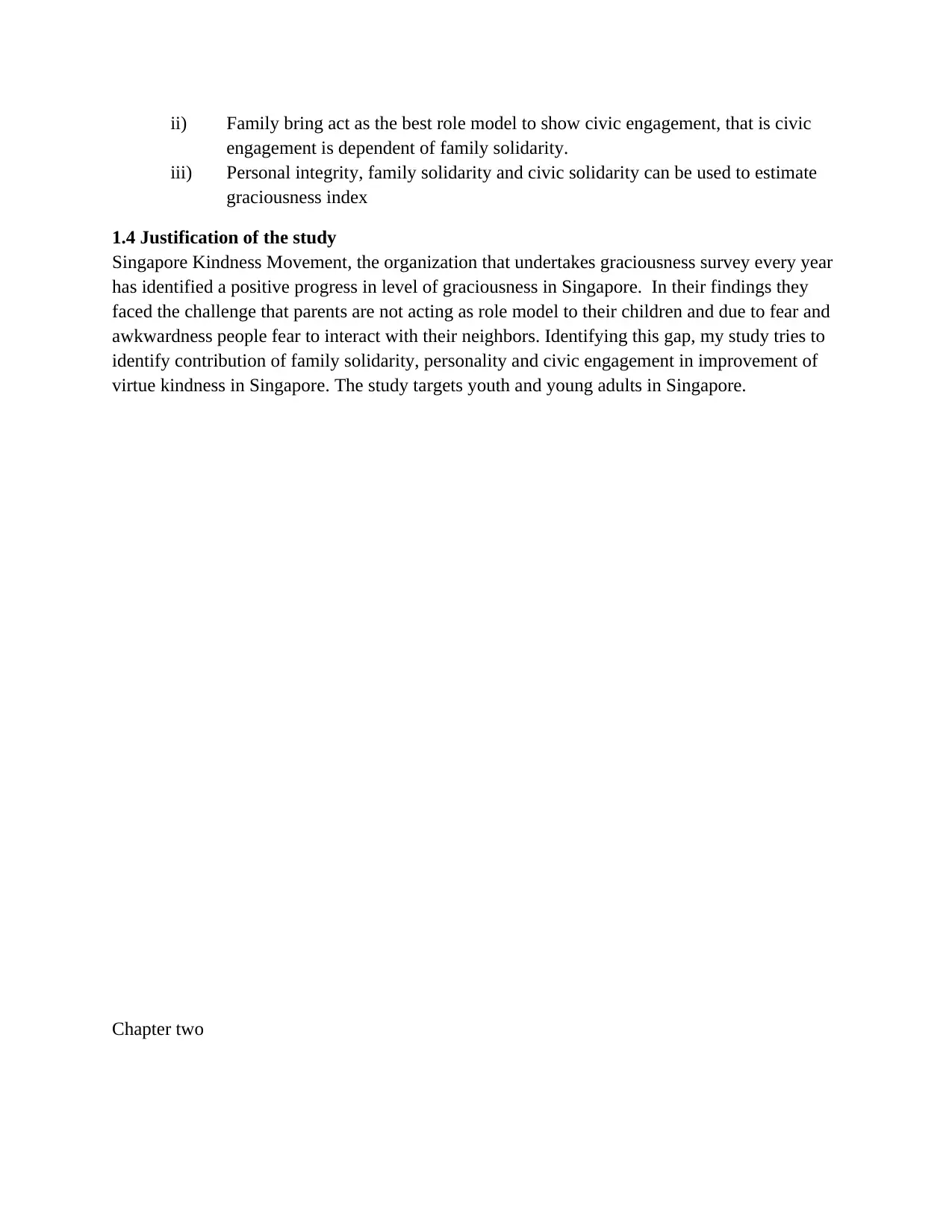
ii) Family bring act as the best role model to show civic engagement, that is civic
engagement is dependent of family solidarity.
iii) Personal integrity, family solidarity and civic solidarity can be used to estimate
graciousness index
1.4 Justification of the study
Singapore Kindness Movement, the organization that undertakes graciousness survey every year
has identified a positive progress in level of graciousness in Singapore. In their findings they
faced the challenge that parents are not acting as role model to their children and due to fear and
awkwardness people fear to interact with their neighbors. Identifying this gap, my study tries to
identify contribution of family solidarity, personality and civic engagement in improvement of
virtue kindness in Singapore. The study targets youth and young adults in Singapore.
Chapter two
engagement is dependent of family solidarity.
iii) Personal integrity, family solidarity and civic solidarity can be used to estimate
graciousness index
1.4 Justification of the study
Singapore Kindness Movement, the organization that undertakes graciousness survey every year
has identified a positive progress in level of graciousness in Singapore. In their findings they
faced the challenge that parents are not acting as role model to their children and due to fear and
awkwardness people fear to interact with their neighbors. Identifying this gap, my study tries to
identify contribution of family solidarity, personality and civic engagement in improvement of
virtue kindness in Singapore. The study targets youth and young adults in Singapore.
Chapter two
Paraphrase This Document
Need a fresh take? Get an instant paraphrase of this document with our AI Paraphraser
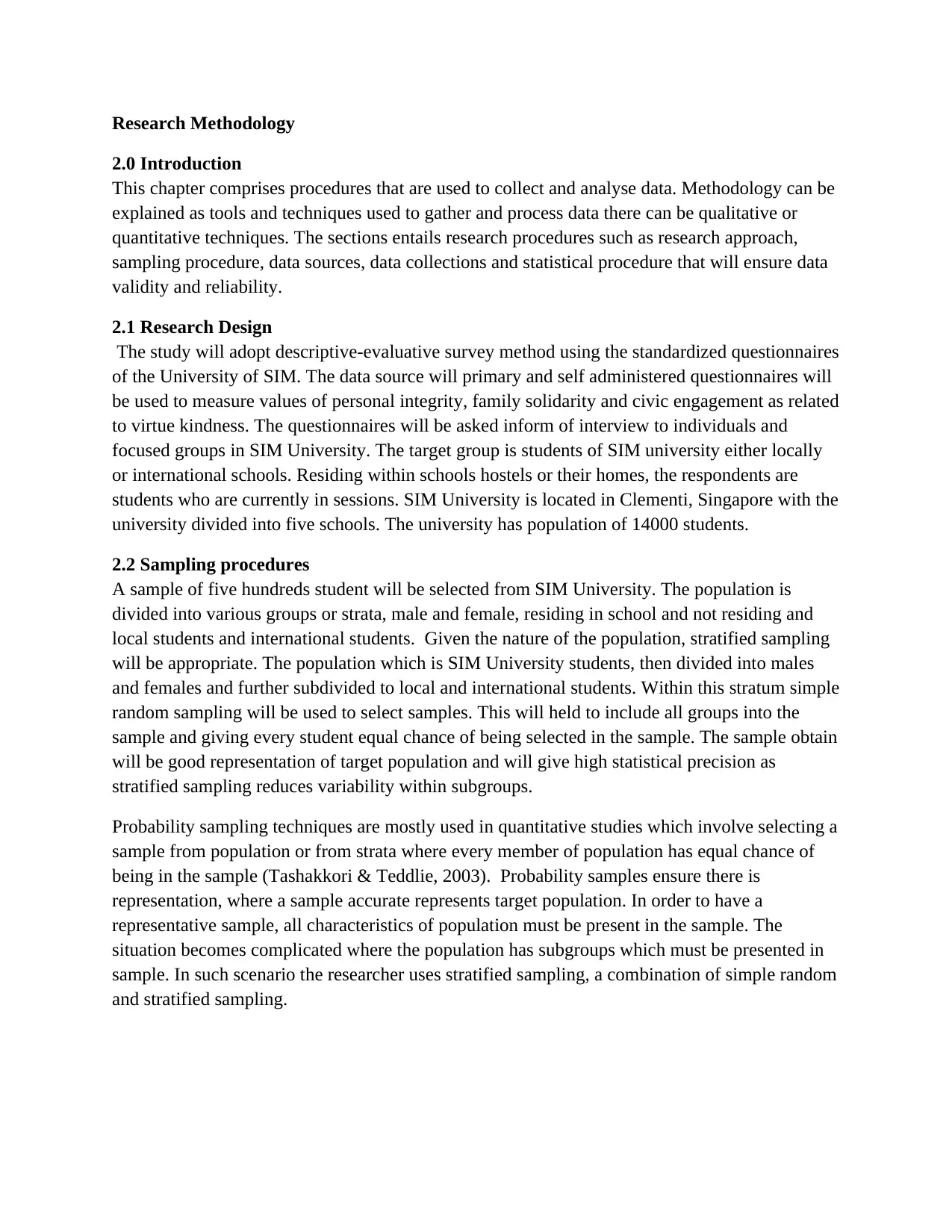
Research Methodology
2.0 Introduction
This chapter comprises procedures that are used to collect and analyse data. Methodology can be
explained as tools and techniques used to gather and process data there can be qualitative or
quantitative techniques. The sections entails research procedures such as research approach,
sampling procedure, data sources, data collections and statistical procedure that will ensure data
validity and reliability.
2.1 Research Design
The study will adopt descriptive-evaluative survey method using the standardized questionnaires
of the University of SIM. The data source will primary and self administered questionnaires will
be used to measure values of personal integrity, family solidarity and civic engagement as related
to virtue kindness. The questionnaires will be asked inform of interview to individuals and
focused groups in SIM University. The target group is students of SIM university either locally
or international schools. Residing within schools hostels or their homes, the respondents are
students who are currently in sessions. SIM University is located in Clementi, Singapore with the
university divided into five schools. The university has population of 14000 students.
2.2 Sampling procedures
A sample of five hundreds student will be selected from SIM University. The population is
divided into various groups or strata, male and female, residing in school and not residing and
local students and international students. Given the nature of the population, stratified sampling
will be appropriate. The population which is SIM University students, then divided into males
and females and further subdivided to local and international students. Within this stratum simple
random sampling will be used to select samples. This will held to include all groups into the
sample and giving every student equal chance of being selected in the sample. The sample obtain
will be good representation of target population and will give high statistical precision as
stratified sampling reduces variability within subgroups.
Probability sampling techniques are mostly used in quantitative studies which involve selecting a
sample from population or from strata where every member of population has equal chance of
being in the sample (Tashakkori & Teddlie, 2003). Probability samples ensure there is
representation, where a sample accurate represents target population. In order to have a
representative sample, all characteristics of population must be present in the sample. The
situation becomes complicated where the population has subgroups which must be presented in
sample. In such scenario the researcher uses stratified sampling, a combination of simple random
and stratified sampling.
2.0 Introduction
This chapter comprises procedures that are used to collect and analyse data. Methodology can be
explained as tools and techniques used to gather and process data there can be qualitative or
quantitative techniques. The sections entails research procedures such as research approach,
sampling procedure, data sources, data collections and statistical procedure that will ensure data
validity and reliability.
2.1 Research Design
The study will adopt descriptive-evaluative survey method using the standardized questionnaires
of the University of SIM. The data source will primary and self administered questionnaires will
be used to measure values of personal integrity, family solidarity and civic engagement as related
to virtue kindness. The questionnaires will be asked inform of interview to individuals and
focused groups in SIM University. The target group is students of SIM university either locally
or international schools. Residing within schools hostels or their homes, the respondents are
students who are currently in sessions. SIM University is located in Clementi, Singapore with the
university divided into five schools. The university has population of 14000 students.
2.2 Sampling procedures
A sample of five hundreds student will be selected from SIM University. The population is
divided into various groups or strata, male and female, residing in school and not residing and
local students and international students. Given the nature of the population, stratified sampling
will be appropriate. The population which is SIM University students, then divided into males
and females and further subdivided to local and international students. Within this stratum simple
random sampling will be used to select samples. This will held to include all groups into the
sample and giving every student equal chance of being selected in the sample. The sample obtain
will be good representation of target population and will give high statistical precision as
stratified sampling reduces variability within subgroups.
Probability sampling techniques are mostly used in quantitative studies which involve selecting a
sample from population or from strata where every member of population has equal chance of
being in the sample (Tashakkori & Teddlie, 2003). Probability samples ensure there is
representation, where a sample accurate represents target population. In order to have a
representative sample, all characteristics of population must be present in the sample. The
situation becomes complicated where the population has subgroups which must be presented in
sample. In such scenario the researcher uses stratified sampling, a combination of simple random
and stratified sampling.
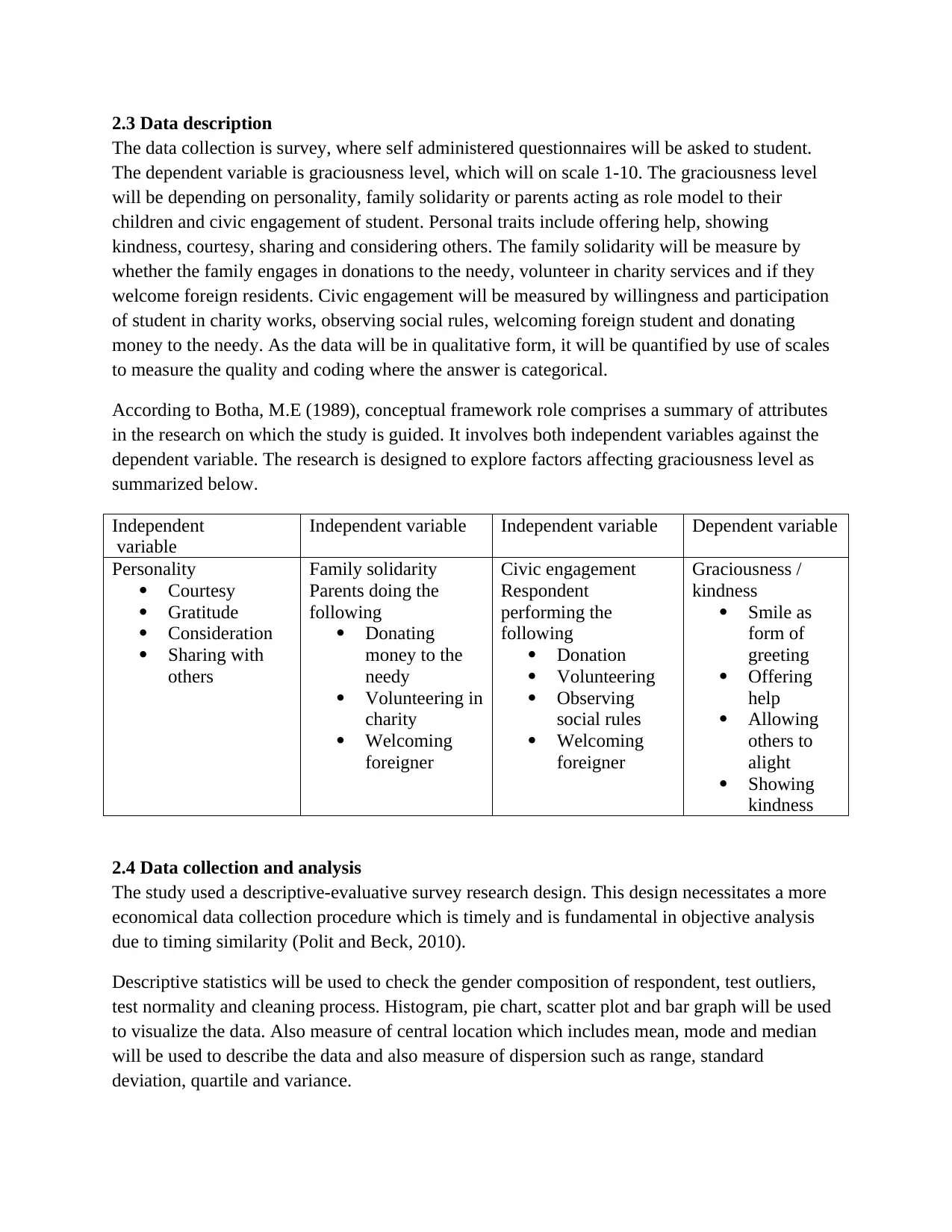
2.3 Data description
The data collection is survey, where self administered questionnaires will be asked to student.
The dependent variable is graciousness level, which will on scale 1-10. The graciousness level
will be depending on personality, family solidarity or parents acting as role model to their
children and civic engagement of student. Personal traits include offering help, showing
kindness, courtesy, sharing and considering others. The family solidarity will be measure by
whether the family engages in donations to the needy, volunteer in charity services and if they
welcome foreign residents. Civic engagement will be measured by willingness and participation
of student in charity works, observing social rules, welcoming foreign student and donating
money to the needy. As the data will be in qualitative form, it will be quantified by use of scales
to measure the quality and coding where the answer is categorical.
According to Botha, M.E (1989), conceptual framework role comprises a summary of attributes
in the research on which the study is guided. It involves both independent variables against the
dependent variable. The research is designed to explore factors affecting graciousness level as
summarized below.
Independent
variable
Independent variable Independent variable Dependent variable
Personality
Courtesy
Gratitude
Consideration
Sharing with
others
Family solidarity
Parents doing the
following
Donating
money to the
needy
Volunteering in
charity
Welcoming
foreigner
Civic engagement
Respondent
performing the
following
Donation
Volunteering
Observing
social rules
Welcoming
foreigner
Graciousness /
kindness
Smile as
form of
greeting
Offering
help
Allowing
others to
alight
Showing
kindness
2.4 Data collection and analysis
The study used a descriptive-evaluative survey research design. This design necessitates a more
economical data collection procedure which is timely and is fundamental in objective analysis
due to timing similarity (Polit and Beck, 2010).
Descriptive statistics will be used to check the gender composition of respondent, test outliers,
test normality and cleaning process. Histogram, pie chart, scatter plot and bar graph will be used
to visualize the data. Also measure of central location which includes mean, mode and median
will be used to describe the data and also measure of dispersion such as range, standard
deviation, quartile and variance.
The data collection is survey, where self administered questionnaires will be asked to student.
The dependent variable is graciousness level, which will on scale 1-10. The graciousness level
will be depending on personality, family solidarity or parents acting as role model to their
children and civic engagement of student. Personal traits include offering help, showing
kindness, courtesy, sharing and considering others. The family solidarity will be measure by
whether the family engages in donations to the needy, volunteer in charity services and if they
welcome foreign residents. Civic engagement will be measured by willingness and participation
of student in charity works, observing social rules, welcoming foreign student and donating
money to the needy. As the data will be in qualitative form, it will be quantified by use of scales
to measure the quality and coding where the answer is categorical.
According to Botha, M.E (1989), conceptual framework role comprises a summary of attributes
in the research on which the study is guided. It involves both independent variables against the
dependent variable. The research is designed to explore factors affecting graciousness level as
summarized below.
Independent
variable
Independent variable Independent variable Dependent variable
Personality
Courtesy
Gratitude
Consideration
Sharing with
others
Family solidarity
Parents doing the
following
Donating
money to the
needy
Volunteering in
charity
Welcoming
foreigner
Civic engagement
Respondent
performing the
following
Donation
Volunteering
Observing
social rules
Welcoming
foreigner
Graciousness /
kindness
Smile as
form of
greeting
Offering
help
Allowing
others to
alight
Showing
kindness
2.4 Data collection and analysis
The study used a descriptive-evaluative survey research design. This design necessitates a more
economical data collection procedure which is timely and is fundamental in objective analysis
due to timing similarity (Polit and Beck, 2010).
Descriptive statistics will be used to check the gender composition of respondent, test outliers,
test normality and cleaning process. Histogram, pie chart, scatter plot and bar graph will be used
to visualize the data. Also measure of central location which includes mean, mode and median
will be used to describe the data and also measure of dispersion such as range, standard
deviation, quartile and variance.
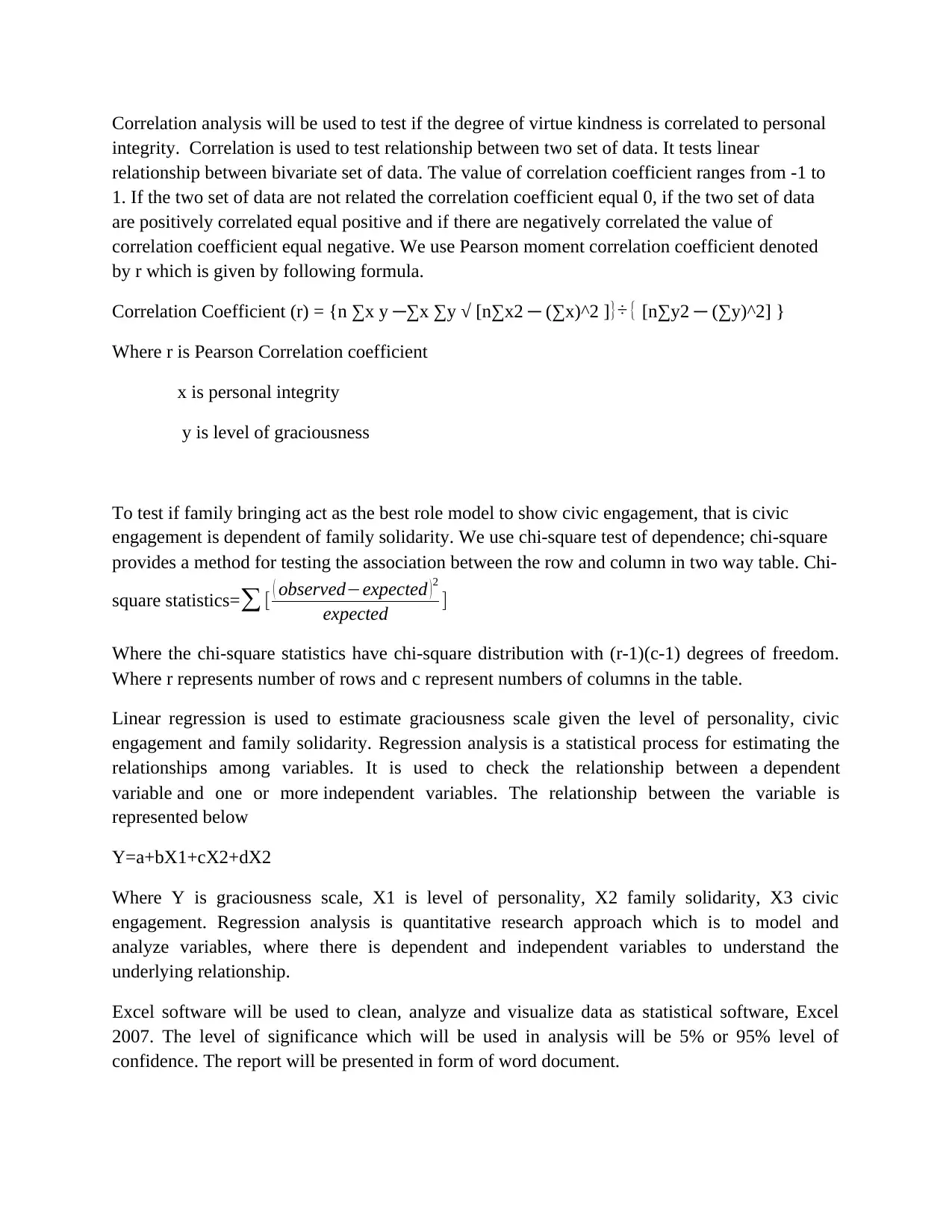
Correlation analysis will be used to test if the degree of virtue kindness is correlated to personal
integrity. Correlation is used to test relationship between two set of data. It tests linear
relationship between bivariate set of data. The value of correlation coefficient ranges from -1 to
1. If the two set of data are not related the correlation coefficient equal 0, if the two set of data
are positively correlated equal positive and if there are negatively correlated the value of
correlation coefficient equal negative. We use Pearson moment correlation coefficient denoted
by r which is given by following formula.
Correlation Coefficient (r) = {n ∑x y ─∑x ∑y √ [n∑x2 ─ (∑x)^2 ]}÷ { [n∑y2 ─ (∑y)^2] }
Where r is Pearson Correlation coefficient
x is personal integrity
y is level of graciousness
To test if family bringing act as the best role model to show civic engagement, that is civic
engagement is dependent of family solidarity. We use chi-square test of dependence; chi-square
provides a method for testing the association between the row and column in two way table. Chi-
square statistics=∑ [ ( observed−expected )2
expected ]
Where the chi-square statistics have chi-square distribution with (r-1)(c-1) degrees of freedom.
Where r represents number of rows and c represent numbers of columns in the table.
Linear regression is used to estimate graciousness scale given the level of personality, civic
engagement and family solidarity. Regression analysis is a statistical process for estimating the
relationships among variables. It is used to check the relationship between a dependent
variable and one or more independent variables. The relationship between the variable is
represented below
Y=a+bX1+cX2+dX2
Where Y is graciousness scale, X1 is level of personality, X2 family solidarity, X3 civic
engagement. Regression analysis is quantitative research approach which is to model and
analyze variables, where there is dependent and independent variables to understand the
underlying relationship.
Excel software will be used to clean, analyze and visualize data as statistical software, Excel
2007. The level of significance which will be used in analysis will be 5% or 95% level of
confidence. The report will be presented in form of word document.
integrity. Correlation is used to test relationship between two set of data. It tests linear
relationship between bivariate set of data. The value of correlation coefficient ranges from -1 to
1. If the two set of data are not related the correlation coefficient equal 0, if the two set of data
are positively correlated equal positive and if there are negatively correlated the value of
correlation coefficient equal negative. We use Pearson moment correlation coefficient denoted
by r which is given by following formula.
Correlation Coefficient (r) = {n ∑x y ─∑x ∑y √ [n∑x2 ─ (∑x)^2 ]}÷ { [n∑y2 ─ (∑y)^2] }
Where r is Pearson Correlation coefficient
x is personal integrity
y is level of graciousness
To test if family bringing act as the best role model to show civic engagement, that is civic
engagement is dependent of family solidarity. We use chi-square test of dependence; chi-square
provides a method for testing the association between the row and column in two way table. Chi-
square statistics=∑ [ ( observed−expected )2
expected ]
Where the chi-square statistics have chi-square distribution with (r-1)(c-1) degrees of freedom.
Where r represents number of rows and c represent numbers of columns in the table.
Linear regression is used to estimate graciousness scale given the level of personality, civic
engagement and family solidarity. Regression analysis is a statistical process for estimating the
relationships among variables. It is used to check the relationship between a dependent
variable and one or more independent variables. The relationship between the variable is
represented below
Y=a+bX1+cX2+dX2
Where Y is graciousness scale, X1 is level of personality, X2 family solidarity, X3 civic
engagement. Regression analysis is quantitative research approach which is to model and
analyze variables, where there is dependent and independent variables to understand the
underlying relationship.
Excel software will be used to clean, analyze and visualize data as statistical software, Excel
2007. The level of significance which will be used in analysis will be 5% or 95% level of
confidence. The report will be presented in form of word document.
Secure Best Marks with AI Grader
Need help grading? Try our AI Grader for instant feedback on your assignments.
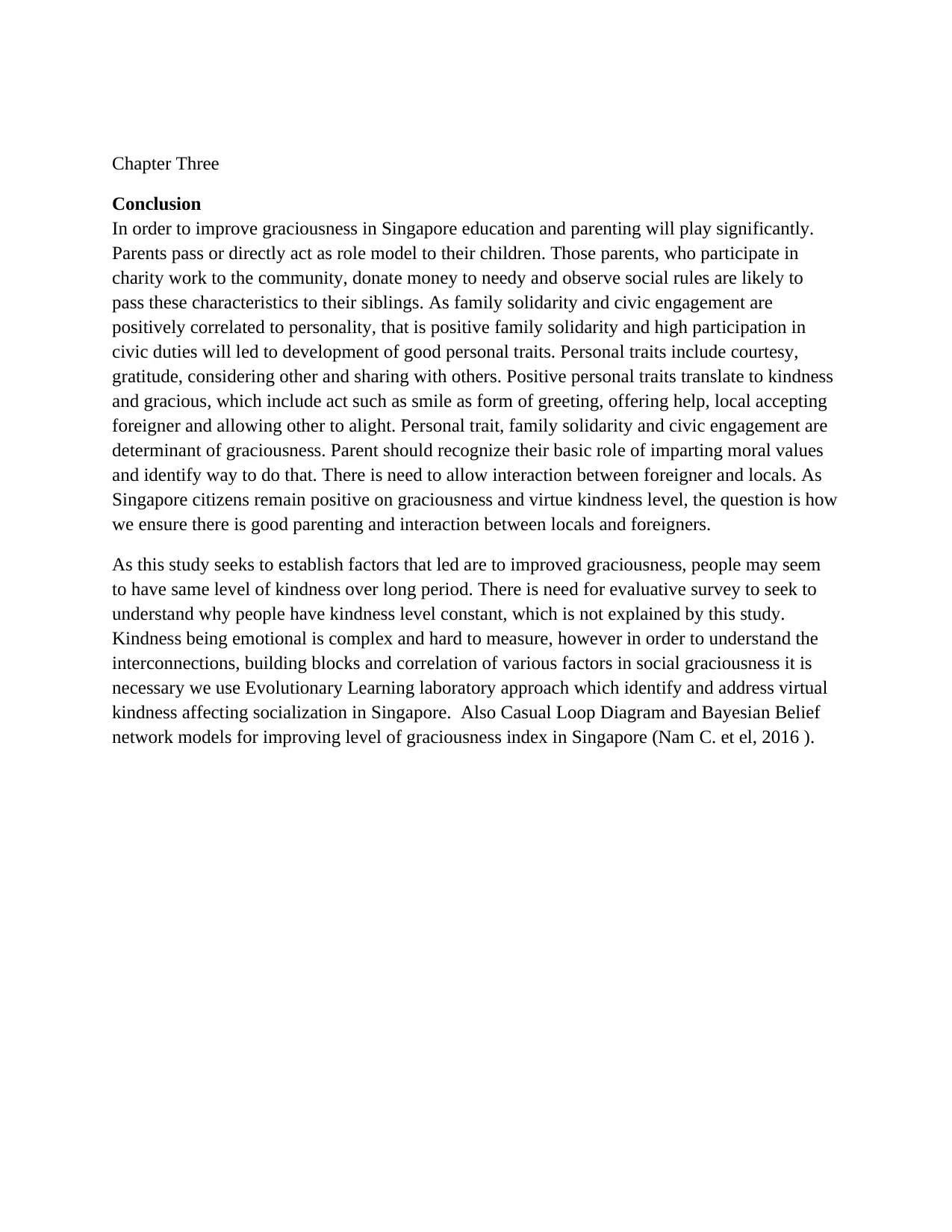
Chapter Three
Conclusion
In order to improve graciousness in Singapore education and parenting will play significantly.
Parents pass or directly act as role model to their children. Those parents, who participate in
charity work to the community, donate money to needy and observe social rules are likely to
pass these characteristics to their siblings. As family solidarity and civic engagement are
positively correlated to personality, that is positive family solidarity and high participation in
civic duties will led to development of good personal traits. Personal traits include courtesy,
gratitude, considering other and sharing with others. Positive personal traits translate to kindness
and gracious, which include act such as smile as form of greeting, offering help, local accepting
foreigner and allowing other to alight. Personal trait, family solidarity and civic engagement are
determinant of graciousness. Parent should recognize their basic role of imparting moral values
and identify way to do that. There is need to allow interaction between foreigner and locals. As
Singapore citizens remain positive on graciousness and virtue kindness level, the question is how
we ensure there is good parenting and interaction between locals and foreigners.
As this study seeks to establish factors that led are to improved graciousness, people may seem
to have same level of kindness over long period. There is need for evaluative survey to seek to
understand why people have kindness level constant, which is not explained by this study.
Kindness being emotional is complex and hard to measure, however in order to understand the
interconnections, building blocks and correlation of various factors in social graciousness it is
necessary we use Evolutionary Learning laboratory approach which identify and address virtual
kindness affecting socialization in Singapore. Also Casual Loop Diagram and Bayesian Belief
network models for improving level of graciousness index in Singapore (Nam C. et el, 2016 ).
Conclusion
In order to improve graciousness in Singapore education and parenting will play significantly.
Parents pass or directly act as role model to their children. Those parents, who participate in
charity work to the community, donate money to needy and observe social rules are likely to
pass these characteristics to their siblings. As family solidarity and civic engagement are
positively correlated to personality, that is positive family solidarity and high participation in
civic duties will led to development of good personal traits. Personal traits include courtesy,
gratitude, considering other and sharing with others. Positive personal traits translate to kindness
and gracious, which include act such as smile as form of greeting, offering help, local accepting
foreigner and allowing other to alight. Personal trait, family solidarity and civic engagement are
determinant of graciousness. Parent should recognize their basic role of imparting moral values
and identify way to do that. There is need to allow interaction between foreigner and locals. As
Singapore citizens remain positive on graciousness and virtue kindness level, the question is how
we ensure there is good parenting and interaction between locals and foreigners.
As this study seeks to establish factors that led are to improved graciousness, people may seem
to have same level of kindness over long period. There is need for evaluative survey to seek to
understand why people have kindness level constant, which is not explained by this study.
Kindness being emotional is complex and hard to measure, however in order to understand the
interconnections, building blocks and correlation of various factors in social graciousness it is
necessary we use Evolutionary Learning laboratory approach which identify and address virtual
kindness affecting socialization in Singapore. Also Casual Loop Diagram and Bayesian Belief
network models for improving level of graciousness index in Singapore (Nam C. et el, 2016 ).
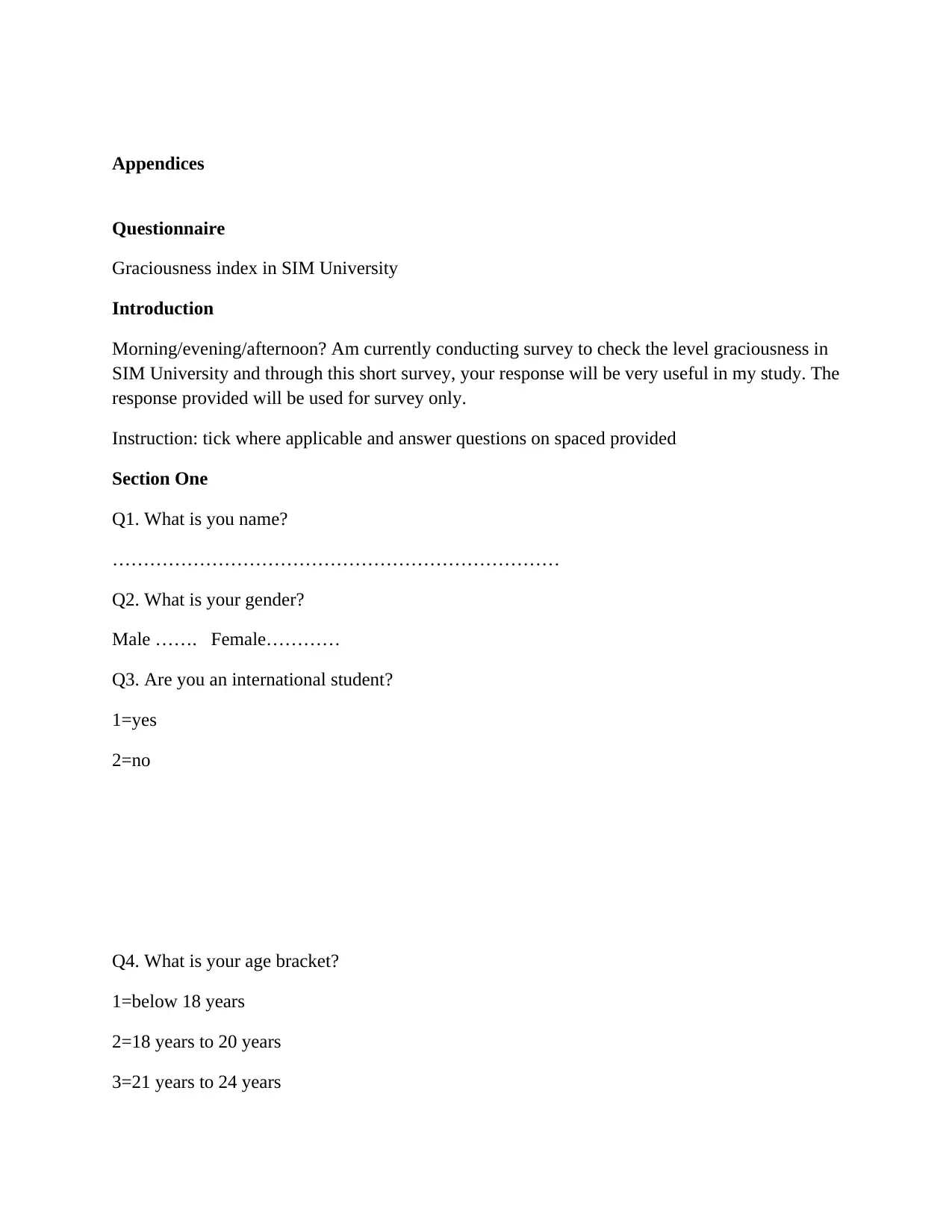
Appendices
Questionnaire
Graciousness index in SIM University
Introduction
Morning/evening/afternoon? Am currently conducting survey to check the level graciousness in
SIM University and through this short survey, your response will be very useful in my study. The
response provided will be used for survey only.
Instruction: tick where applicable and answer questions on spaced provided
Section One
Q1. What is you name?
………………………………………………………………
Q2. What is your gender?
Male ……. Female…………
Q3. Are you an international student?
1=yes
2=no
Q4. What is your age bracket?
1=below 18 years
2=18 years to 20 years
3=21 years to 24 years
Questionnaire
Graciousness index in SIM University
Introduction
Morning/evening/afternoon? Am currently conducting survey to check the level graciousness in
SIM University and through this short survey, your response will be very useful in my study. The
response provided will be used for survey only.
Instruction: tick where applicable and answer questions on spaced provided
Section One
Q1. What is you name?
………………………………………………………………
Q2. What is your gender?
Male ……. Female…………
Q3. Are you an international student?
1=yes
2=no
Q4. What is your age bracket?
1=below 18 years
2=18 years to 20 years
3=21 years to 24 years
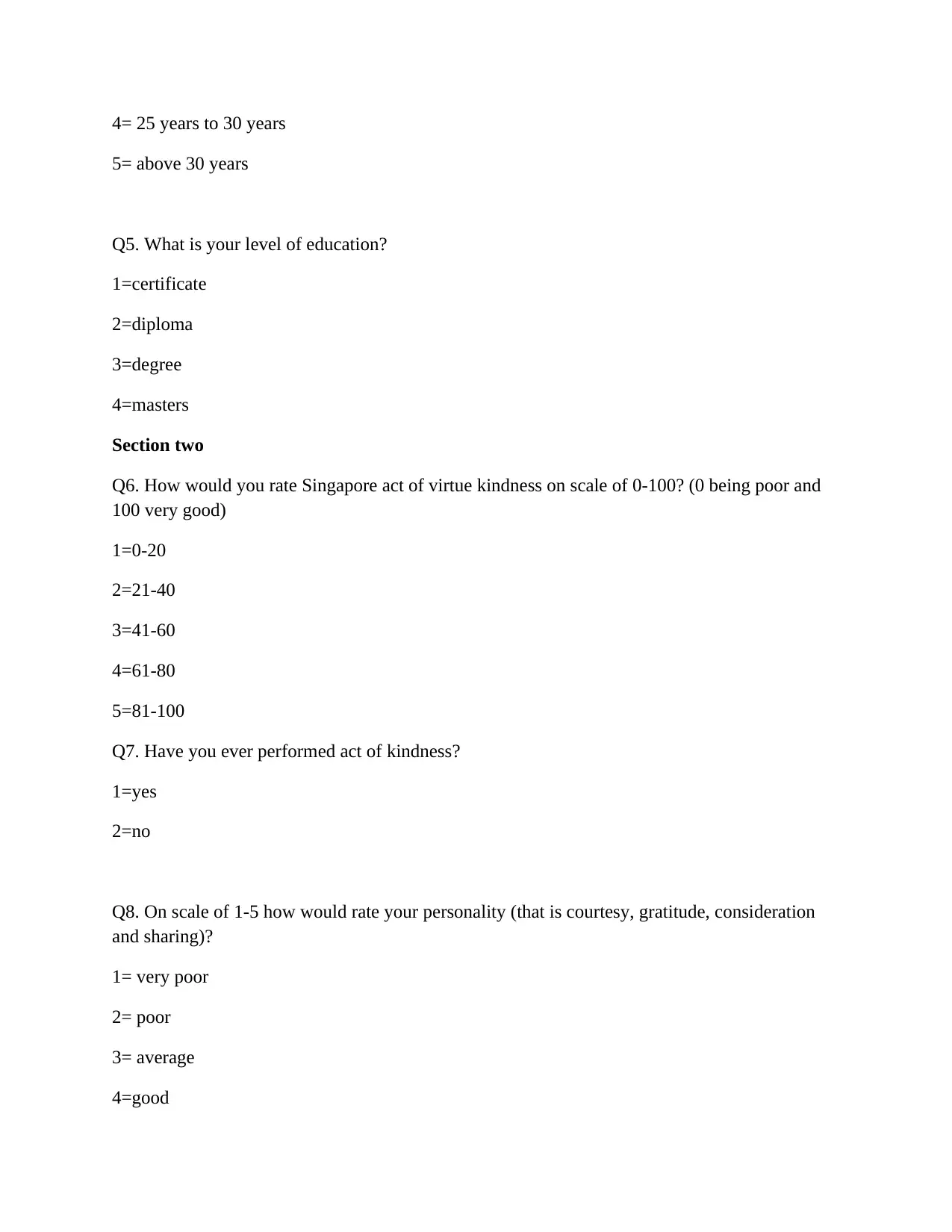
4= 25 years to 30 years
5= above 30 years
Q5. What is your level of education?
1=certificate
2=diploma
3=degree
4=masters
Section two
Q6. How would you rate Singapore act of virtue kindness on scale of 0-100? (0 being poor and
100 very good)
1=0-20
2=21-40
3=41-60
4=61-80
5=81-100
Q7. Have you ever performed act of kindness?
1=yes
2=no
Q8. On scale of 1-5 how would rate your personality (that is courtesy, gratitude, consideration
and sharing)?
1= very poor
2= poor
3= average
4=good
5= above 30 years
Q5. What is your level of education?
1=certificate
2=diploma
3=degree
4=masters
Section two
Q6. How would you rate Singapore act of virtue kindness on scale of 0-100? (0 being poor and
100 very good)
1=0-20
2=21-40
3=41-60
4=61-80
5=81-100
Q7. Have you ever performed act of kindness?
1=yes
2=no
Q8. On scale of 1-5 how would rate your personality (that is courtesy, gratitude, consideration
and sharing)?
1= very poor
2= poor
3= average
4=good
Paraphrase This Document
Need a fresh take? Get an instant paraphrase of this document with our AI Paraphraser
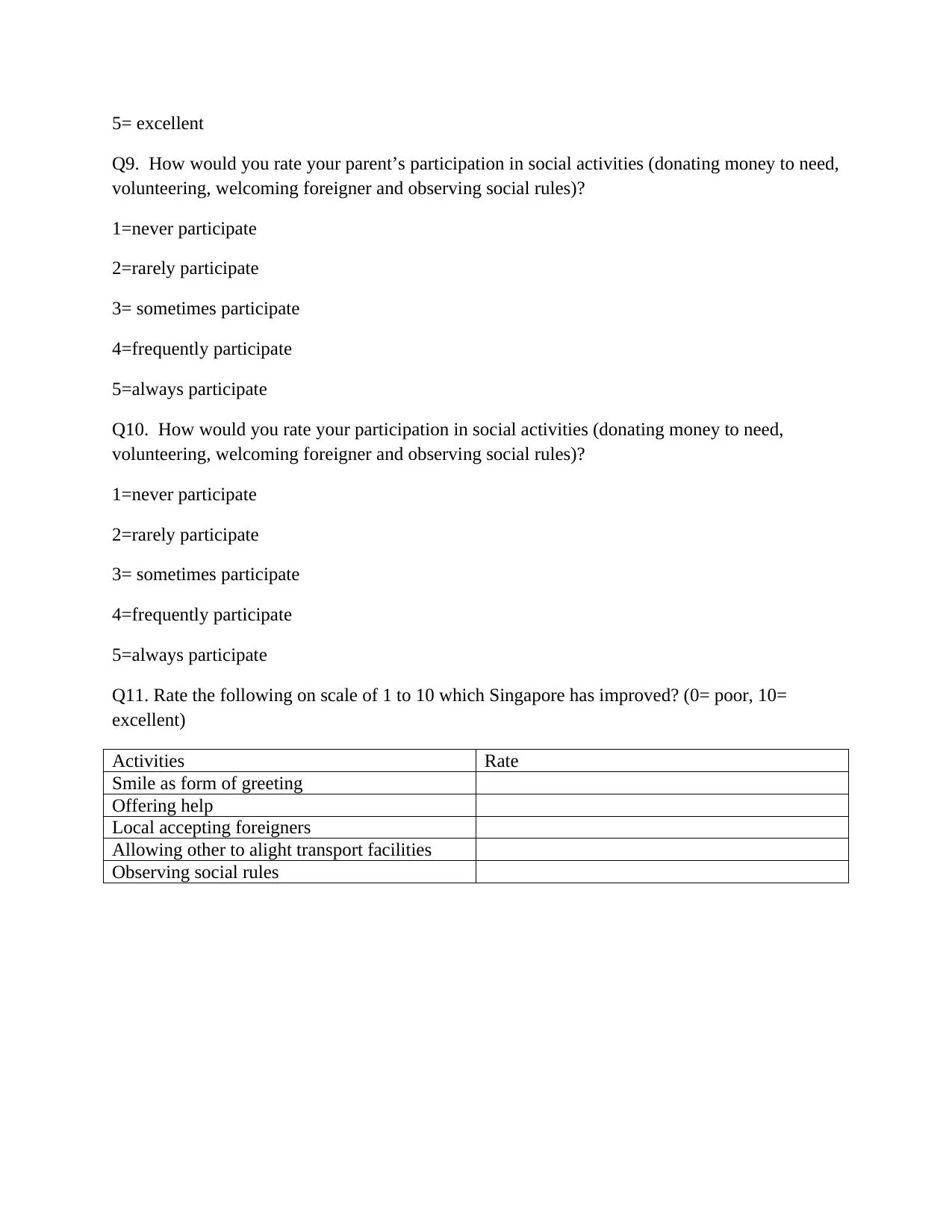
5= excellent
Q9. How would you rate your parent’s participation in social activities (donating money to need,
volunteering, welcoming foreigner and observing social rules)?
1=never participate
2=rarely participate
3= sometimes participate
4=frequently participate
5=always participate
Q10. How would you rate your participation in social activities (donating money to need,
volunteering, welcoming foreigner and observing social rules)?
1=never participate
2=rarely participate
3= sometimes participate
4=frequently participate
5=always participate
Q11. Rate the following on scale of 1 to 10 which Singapore has improved? (0= poor, 10=
excellent)
Activities Rate
Smile as form of greeting
Offering help
Local accepting foreigners
Allowing other to alight transport facilities
Observing social rules
Q9. How would you rate your parent’s participation in social activities (donating money to need,
volunteering, welcoming foreigner and observing social rules)?
1=never participate
2=rarely participate
3= sometimes participate
4=frequently participate
5=always participate
Q10. How would you rate your participation in social activities (donating money to need,
volunteering, welcoming foreigner and observing social rules)?
1=never participate
2=rarely participate
3= sometimes participate
4=frequently participate
5=always participate
Q11. Rate the following on scale of 1 to 10 which Singapore has improved? (0= poor, 10=
excellent)
Activities Rate
Smile as form of greeting
Offering help
Local accepting foreigners
Allowing other to alight transport facilities
Observing social rules
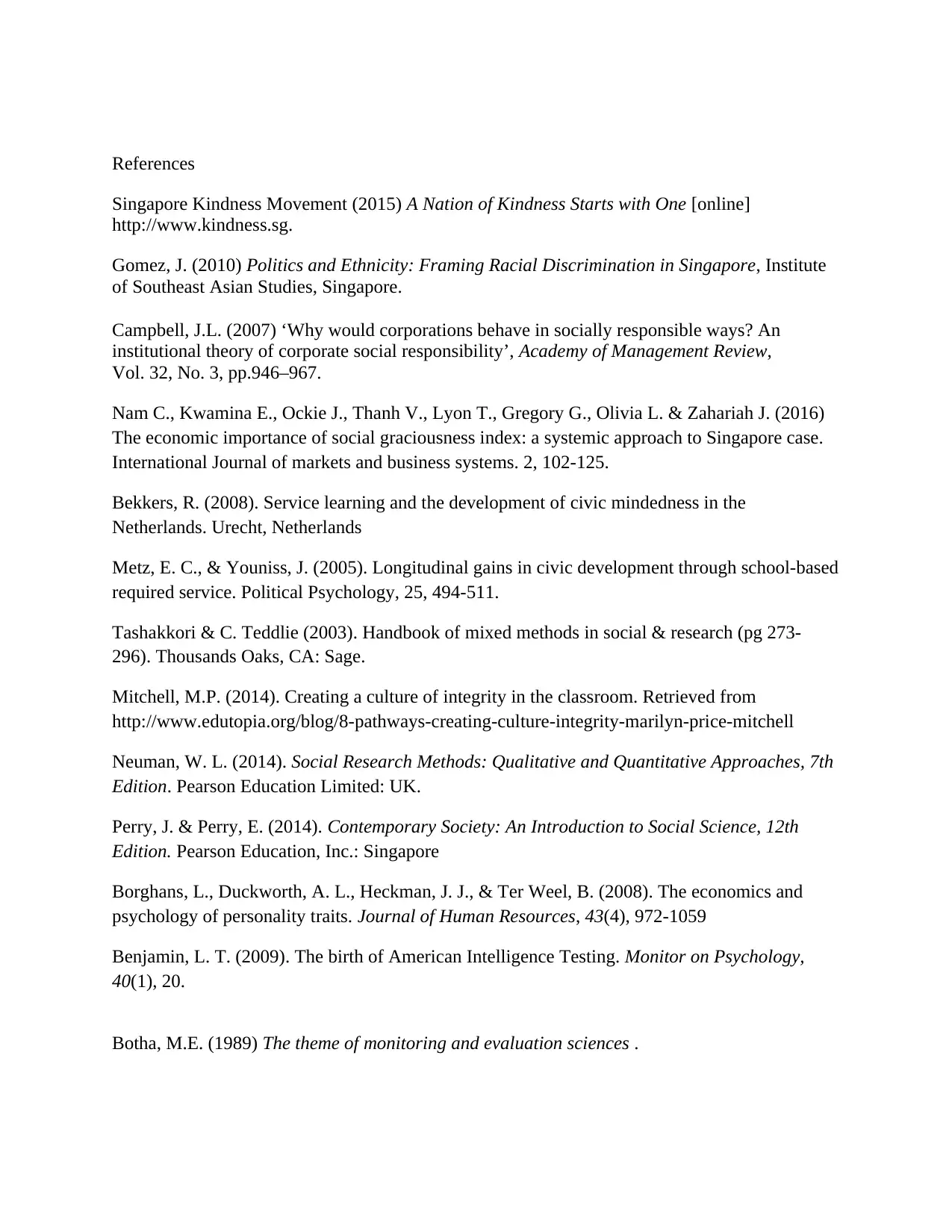
References
Singapore Kindness Movement (2015) A Nation of Kindness Starts with One [online]
http://www.kindness.sg.
Gomez, J. (2010) Politics and Ethnicity: Framing Racial Discrimination in Singapore, Institute
of Southeast Asian Studies, Singapore.
Campbell, J.L. (2007) ‘Why would corporations behave in socially responsible ways? An
institutional theory of corporate social responsibility’, Academy of Management Review,
Vol. 32, No. 3, pp.946–967.
Nam C., Kwamina E., Ockie J., Thanh V., Lyon T., Gregory G., Olivia L. & Zahariah J. (2016)
The economic importance of social graciousness index: a systemic approach to Singapore case.
International Journal of markets and business systems. 2, 102-125.
Bekkers, R. (2008). Service learning and the development of civic mindedness in the
Netherlands. Urecht, Netherlands
Metz, E. C., & Youniss, J. (2005). Longitudinal gains in civic development through school-based
required service. Political Psychology, 25, 494-511.
Tashakkori & C. Teddlie (2003). Handbook of mixed methods in social & research (pg 273-
296). Thousands Oaks, CA: Sage.
Mitchell, M.P. (2014). Creating a culture of integrity in the classroom. Retrieved from
http://www.edutopia.org/blog/8-pathways-creating-culture-integrity-marilyn-price-mitchell
Neuman, W. L. (2014). Social Research Methods: Qualitative and Quantitative Approaches, 7th
Edition. Pearson Education Limited: UK.
Perry, J. & Perry, E. (2014). Contemporary Society: An Introduction to Social Science, 12th
Edition. Pearson Education, Inc.: Singapore
Borghans, L., Duckworth, A. L., Heckman, J. J., & Ter Weel, B. (2008). The economics and
psychology of personality traits. Journal of Human Resources, 43(4), 972-1059
Benjamin, L. T. (2009). The birth of American Intelligence Testing. Monitor on Psychology,
40(1), 20.
Botha, M.E. (1989) The theme of monitoring and evaluation sciences .
Singapore Kindness Movement (2015) A Nation of Kindness Starts with One [online]
http://www.kindness.sg.
Gomez, J. (2010) Politics and Ethnicity: Framing Racial Discrimination in Singapore, Institute
of Southeast Asian Studies, Singapore.
Campbell, J.L. (2007) ‘Why would corporations behave in socially responsible ways? An
institutional theory of corporate social responsibility’, Academy of Management Review,
Vol. 32, No. 3, pp.946–967.
Nam C., Kwamina E., Ockie J., Thanh V., Lyon T., Gregory G., Olivia L. & Zahariah J. (2016)
The economic importance of social graciousness index: a systemic approach to Singapore case.
International Journal of markets and business systems. 2, 102-125.
Bekkers, R. (2008). Service learning and the development of civic mindedness in the
Netherlands. Urecht, Netherlands
Metz, E. C., & Youniss, J. (2005). Longitudinal gains in civic development through school-based
required service. Political Psychology, 25, 494-511.
Tashakkori & C. Teddlie (2003). Handbook of mixed methods in social & research (pg 273-
296). Thousands Oaks, CA: Sage.
Mitchell, M.P. (2014). Creating a culture of integrity in the classroom. Retrieved from
http://www.edutopia.org/blog/8-pathways-creating-culture-integrity-marilyn-price-mitchell
Neuman, W. L. (2014). Social Research Methods: Qualitative and Quantitative Approaches, 7th
Edition. Pearson Education Limited: UK.
Perry, J. & Perry, E. (2014). Contemporary Society: An Introduction to Social Science, 12th
Edition. Pearson Education, Inc.: Singapore
Borghans, L., Duckworth, A. L., Heckman, J. J., & Ter Weel, B. (2008). The economics and
psychology of personality traits. Journal of Human Resources, 43(4), 972-1059
Benjamin, L. T. (2009). The birth of American Intelligence Testing. Monitor on Psychology,
40(1), 20.
Botha, M.E. (1989) The theme of monitoring and evaluation sciences .

1 out of 16
Related Documents
Your All-in-One AI-Powered Toolkit for Academic Success.
+13062052269
info@desklib.com
Available 24*7 on WhatsApp / Email
![[object Object]](/_next/static/media/star-bottom.7253800d.svg)
Unlock your academic potential
© 2024 | Zucol Services PVT LTD | All rights reserved.





